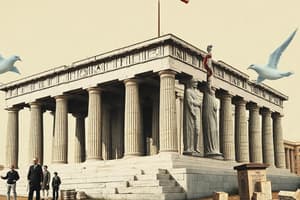Podcast
Questions and Answers
Which of the following regions was NOT considered part of the core of the Greco-Roman world?
Which of the following regions was NOT considered part of the core of the Greco-Roman world?
- Cyprus
- Macedonian region (correct)
- Iberian Peninsula
- Gaul
What was the lingua franca of the Greco-Roman world?
What was the lingua franca of the Greco-Roman world?
- Arabic and Hebrew
- Greek and Latin (correct)
- Celtic and Germanic
- Slavic and Baltic
Which empire was another 'world' to the east of the Greco-Roman world with which there was constant interaction?
Which empire was another 'world' to the east of the Greco-Roman world with which there was constant interaction?
- Byzantine Empire
- Persian Empire (correct)
- Ottoman Empire
- Mongol Empire
What was the result of the syncretism between Roman and Greek myths?
What was the result of the syncretism between Roman and Greek myths?
What were the foundations of education transmitted throughout the lands of Greek and Roman rule in schools of?
What were the foundations of education transmitted throughout the lands of Greek and Roman rule in schools of?
Which of the following regions was NOT part of the periphery of the Greco-Roman world?
Which of the following regions was NOT part of the periphery of the Greco-Roman world?
What was the year when all of the empire's free men became citizens with all the rights this entailed?
What was the year when all of the empire's free men became citizens with all the rights this entailed?
What was the geographical region centered on the Mediterranean and Black Sea Basins referred to as?
What was the geographical region centered on the Mediterranean and Black Sea Basins referred to as?
Where did Graeco-Roman architecture in the Roman world follow the principles and style that had been established by ancient Greece?
Where did Graeco-Roman architecture in the Roman world follow the principles and style that had been established by ancient Greece?
Flashcards
Macedonian region and Greco-Roman core
Macedonian region and Greco-Roman core
The Macedonian region was not considered part of the core of the Greco-Roman world.
Lingua franca of the Greco-Roman world
Lingua franca of the Greco-Roman world
Greek and Latin were the languages commonly used in the Greco-Roman world.
Persian Empire and Greco-Roman world
Persian Empire and Greco-Roman world
The Persian Empire was a major power east of the Greco-Roman world, constantly interacting with it.
Greco-Roman mythology
Greco-Roman mythology
Signup and view all the flashcards
Education in Greco-Roman world
Education in Greco-Roman world
Signup and view all the flashcards
Sinai Peninsula and Greco-Roman periphery
Sinai Peninsula and Greco-Roman periphery
Signup and view all the flashcards
Full Roman citizenship for all free men
Full Roman citizenship for all free men
Signup and view all the flashcards
Mediterranean world
Mediterranean world
Signup and view all the flashcards
Roman architecture and Greek influence
Roman architecture and Greek influence
Signup and view all the flashcards
Study Notes
Areas of influence by ancient Greece and Rome:
- The Greco-Roman civilization refers to the geographical regions and countries that were influenced by the language, culture, government, and religion of the Greeks and Romans.
- The area refers to the "Mediterranean world", the extensive tracts of land centered on the Mediterranean and Black Sea Basins.
- Greek and Latin became the languages of the urban and cosmopolitan elites and the Empire's lingua franca for those who lived within the large territories and populations outside the Macedonian settlements and the Roman colonies.
- The cores of the Greco-Roman world were the Italian Peninsula, Greece, Cyprus, the Iberian Peninsula, the Anatolian Peninsula, Gaul, the Syrian region, Egypt, and Roman Africa.
- The periphery of that world was occupied by the so-called "Roman Germany", the Illyricum, the Macedonian region, Thrace, Moesia, and Pannonia.
- The Greco-Roman world also included Dacia, Mauretania, Jordan, Southern Syria, Egypt's Sinai Peninsula, and the Tauric Chersonesus.
- The Persian Empire was another "world" to the east of the Greco-Roman world with which there was constant interaction.
- The foundations of education were transmitted throughout the lands of Greek and Roman rule in schools of art, philosophy, and rhetoric.
- Graeco-Roman architecture in the Roman world followed the principles and style that had been established by ancient Greece.
- By AD 211, all of the empire's free men became citizens with all the rights this entailed.
- Greco-Roman mythology, sometimes called classical mythology, is the result of the syncretism between Roman and Greek myths.
- Early Christianity was born in the world of Greco-Roman influence which had a massive influence on Christian culture.
Studying That Suits You
Use AI to generate personalized quizzes and flashcards to suit your learning preferences.




